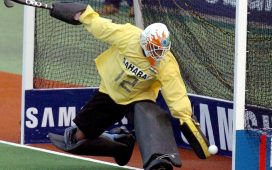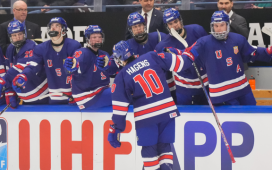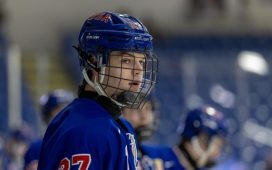Sure, the Dallas Stars nearly won their way to the Western Conference final last season and came within one goal of the penultimate series of the playoffs, but on a personal level, it was a forgettable campaign for Jamie Benn.
After near 90-point performances in back-to-back seasons, 2014-15 and 2015-16, Benn watched his point total dip to 69 in 2016-17 but managed to find his form again with a 36-goal, 79-point output during the 2017-18 campaign. The hope, then, was that the 2018-19 season would the former Art Ross Trophy winner build on that showing, eclipse the 90-point plateau and again cement himself as one of the premier offensive players in the NHL.
That…didn’t happen. Instead, Benn struggled, and struggled to such a degree that he was publicly called out by Stars CEO Jim Lites. By the time the campaign concluded, the Stars were in the post-season, but Benn’s battle with inconsistency resulted in a 53-point output, the third-lowest of his career, and saw the Dallas’ highest-paid player finish a full 27 points off the team scoring lead and third on the list behind Tyler Seguin and Alexander Radulov.
Given his limited production and 26-point drop off from the year prior, Benn was one of the more notable names who suffered through a significant dip in offensive output, but he wasn’t alone. Eric Staal, Patrik Laine and Rickard Rakell were also among those who took a major step backwards. So, who will be affected by a similar decline this coming season? Here are five high-scoring players whose point total could dwindle in 2019-20:
Phil Kessel, Arizona Coyotes
Guess how many players have outproduced Kessel over the past four seasons. Somewhere in the 20s? Maybe even 30 players? Wrong. It’s 11 players, as Kessel’s 303 points tie him with Leon Draisaitl and Seguin over the past four campaigns. It’s a veritable who’s who atop the scoring list over that span, and Kessel is right there alongside them. This is to say that Kessel’s offensive decline next season will have little to do with his own ability and much more to do with his environment.
As much as Kessel is a pure offensive player and sure to be the leader in Arizona, he’s heading to a Coyotes team that was in the bottom half of the league in shots last season and prides itself on limiting opponents as much as creating offense of its own. No Coyote scored more than 19 goals last season – Alex Galchenyuk, who was sent to the Pittsburgh Penguins in the Kessel trade – and Clayton Keller’s 47 points was the team-high mark. Kessel’s not going to fall apart, but he won’t be the 82-point player he was in 2018-19.
Mark Giordano, Calgary Flames
Fine wines only wish they could age like Giordano, who has played some of the best hockey of his entire career past his 30th birthday and is fresh off of his first Norris Trophy victory – not to mention his first trip to the banquet as a finalist – at the ripe old age of 35. He’s going to remain the top defender for the Flames, a true No. 1 on the blueline. But it’s a safe bet to suggest he won’t be replicating his 74-point output.
First, last season’s point total saw him nearly double his offensive performance from the campaign prior and the campaign before that, both of which were sub-40-point seasons. Second, his assist total was 20 clear of where it had been during his previous career-best campaigns. And finally, more than half of his helpers and more than 40 percent of his point total came by way of secondary assists, of which he racked up 1.02 per 60 minutes of ice time. That’s one-quarter of a secondary assist higher than his previous career high. It’s unlikely that holds.
Mats Zuccarello, Minnesota Wild
From an overall point total perspective, Zuccarello might not be a first-choice for this group. His 40 points last season tied him for 167th in scoring last season and it was, by season’s end, the second-lowest point total of his career. However, Zuccarello only played in 48 games, and measured on a per game basis, he’s never been more prolific. His .25 goals per game matched the second-best mark of his career, his .58 assists per game was his career-best rate and his .83 points per game was the first time he had cracked the .80 plateau.
So, why does he take a step back? Like Kessel, it comes down to team success. Not only are the Wild projected to finish outside of the playoff picture this coming season, they also finished the past campaign with an expected goals rate that was one of the 10-lowest in the NHL. They’re not an offensively flashy bunch and that could make for tough sledding for Zuccarello during his debut campaign in the State of Hockey.
Erik Gustafsson, Chicago Blackhawks
The only defensemen who finished with more points than Gustafsson last season were Giordano, Brent Burns, Morgan Rielly, John Carlson and Keith Yandle. That’s the complete list. The Blackhawks rearguard had a dream season, scoring 17 goals, the third-most of any rearguard, and finishing with 60 points. That saw him surpass his previous career bests by a dozen goals and a whopping 44 points. Call this one a hunch, though, as it seems unlikely he’s about to spend two consecutive seasons as one of the league’s highest-scoring defensemen.
Working against Gustafsson as much as anything is the influx of defenders in Chicago. The Blackhawks brought in Olli Maatta and Calvin de Haan this summer, and the two rearguards are going to battle for spots in the top four, though the former is slated to miss the first month of the season. If Gustafsson loses some of his minutes – he was second with 22:35 per game in Chicago last season – his offense will suffer.
Cam Atkinson, Columbus Blue Jackets
Losing Artemi Panarin is going to have an impact on individual players, and there may be no player who feels the loss of the skillful winger as much as Atkinson. The two were largely inseparable last season, to the extent that Atkinson played 1,119 minutes with Panarin and only 377 without. And what impact did that have on Atkinson? Well, Panarin had the primary assist on 13 of Atkinson’s 41 goals last season or 32 percent of his overall goal total. Panarin had an assist of either variety on 19 of the 41 tallies, too, which is flirting with half.
We’ve seen Atkinson have his ups and downs before, as well. After his breakout 35-goal campaign in 2016-17, he struggled and posted just 24 goals the following season with a goals per game rate that was notably lower than the campaign prior. In the wake of a season in which he set career-best goal and point totals, Atkinson will need time to adjust to life without his wingman. He’ll get there, but it’s not going to happen overnight.
(All advanced statistics via NaturalStatTrick)
Want more in-depth features, analysis and an All-Access pass to the latest content? Subscribe to The Hockey News magazine.








